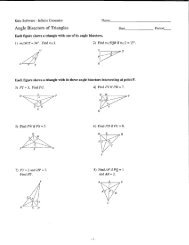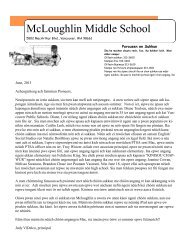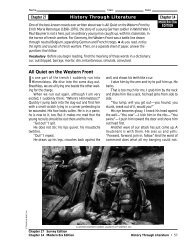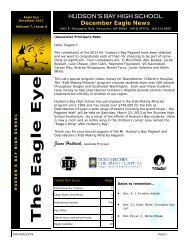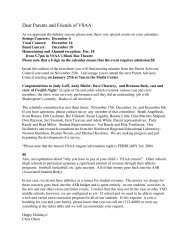Stellar Evolution Project
Stellar Evolution Project
Stellar Evolution Project
You also want an ePaper? Increase the reach of your titles
YUMPU automatically turns print PDFs into web optimized ePapers that Google loves.
<strong>Stellar</strong> <strong>Evolution</strong><br />
For this assignment, you will show your understanding of how stars change during their existence by choosing one of<br />
the following:<br />
1) creating a 1 to 4 frame comic.<br />
2) writing a poem.<br />
3) creating a set of character sketches (with portraits).<br />
Look over your notes from class about stellar evolution and chapter 29 in your textbook. Be aware of the different<br />
paths a star may follow in stellar evolution and the reasons for differences in evolution of stars. Connect these<br />
different paths to the different classifications of stars as shown on the H-R diagram you created. Be able to describe<br />
how stars must find equilibrium between gravity and the forces created by nuclear fusion.<br />
Consider the concepts of stellar evolution and think of a metaphor/analogy to use that can show the concepts well<br />
(like the gambler in the video). Decide which of the methods listed at the page top you would like to use to show<br />
your understanding of stellar evolution. Your project must show the perspectives of at least three different star<br />
pathways. We have created comics and poems in class before and the same standards apply. You may examine your<br />
previous handouts for that information.<br />
The basic stages of stellar evolution to include:<br />
• origins of stars (how born)<br />
• equilibrium of gravity and nuclear fusion to form a star<br />
• role of nuclear fusion in the formation of heavier elements<br />
• how the star’s mass affects the path of the star through the star cycle<br />
• different ways stars die (and why these deaths are different)<br />
Write an artist’s statement that explains the process and concepts behind what you create. This statement should<br />
include three parts (clearly identified and separate):<br />
What did you do What science knowledge does this project represent Explain the science behind the project.<br />
Describe what stages of stellar evolution you show and the different types of stars you examine. Be sure to define<br />
and explain relevant terms.<br />
How did you do it Explain how the project connects to the concepts you describe above. What metaphors do<br />
you use to show your understanding Describe how you consider the viewpoint for at least three different types of<br />
stars/outcomes in your project. Be specific.<br />
Why did you do it the way you did Discuss what prior knowledge or preferences led you to create the project in<br />
the way you did. From all of your brainstorming ideas, why did you end up choosing this one How did this idea<br />
help you understand stellar evolution better<br />
The artist statement must be typed and turned in as instructed. DUE DATE:<br />
Scoring<br />
<strong>Project</strong> (8 pts)<br />
Artist<br />
Statement<br />
(8 pts)<br />
4 3 2 1<br />
Generally accurate for at least Accurately shows three<br />
four elements of stellar elements of stellar<br />
evolution.<br />
evolution.<br />
May need artist statement for Marks, etc. detract from<br />
reader to understand clearly. viewing.<br />
Neatly presented. Marks, etc.<br />
do not detract from viewing.<br />
Accurately and clearly<br />
all of the elements of<br />
stellar evolution.<br />
Neatly presented.<br />
Completely and<br />
accurately covers all<br />
three sections with<br />
detail and examples.<br />
Accurately covers all three<br />
sections described above.<br />
Descriptions are complete<br />
enough to show<br />
understanding.<br />
Description of process and<br />
product largely accurate,<br />
but includes significant<br />
errors and/or not clearly<br />
connect to comic/concept.<br />
Does not accurately show<br />
elements of stellar<br />
evolution.<br />
Messy.<br />
Does not describe concepts<br />
or comic very accurately.
Creating a Character Sketch: elements to include<br />
• Name<br />
• Age<br />
• Height<br />
• Eye color<br />
• Hair color<br />
• Other physical traits<br />
• What is the character’s major goal<br />
• Why is this goal important to the character<br />
• Are there past events that affect the relevance of this goal<br />
• Describe your character’s life experiences up until now/ family<br />
situation/motivations/pet peeves, etc.<br />
• What are the character’s future ambitions<br />
Each character should have a simple portrait (color optional).<br />
Stages of <strong>Stellar</strong> <strong>Evolution</strong> to address:<br />
• birth of star<br />
• main sequence<br />
• death<br />
Terms<br />
Protostar Nebula Main sequence star<br />
White dwarf Red giant Red Supergiant<br />
Planetary nebula Black hole Neutron star<br />
Supernova Hydrogen burning/ thermonuclear fusion Formation of heavier elements<br />
Significance of<br />
temperature/color/spectra<br />
H-R diagram<br />
Significance of mass<br />
Gravity<br />
9-11 ES1A Stars have “life cycles.” During most of their<br />
“lives”, stars produce heavier elements from<br />
lighter elements starting with the fusion of<br />
hydrogen to form helium. The heaviest<br />
elements are formed when massive stars “die”<br />
in massive explosions.<br />
• Connect the life cycles of stars to the<br />
production of elements through the process<br />
of nuclear fusion.<br />
9-12 SYSD Systems can be changing or in equilibrium. • Analyze whether or not a system (e.g.,<br />
population) is changing or in equilibrium. *c<br />
9-11 PS3E Electromagnetic waves differ from physical<br />
waves because they do not require a<br />
medium and they all travel at the same<br />
speed in a vacuum. This is the maximum<br />
speed that any object or wave can travel.<br />
Forms of electromagnetic waves include X-<br />
rays, ultraviolet, visible light, infrared, and<br />
radio.<br />
• Determine whether a state of equilibrium is<br />
static or dynamic (e.g., inflows equal<br />
outflows). *c<br />
• Illustrate the electromagnetic spectrum with<br />
a labeled diagram, showing how regions of<br />
the spectrum differ regarding wavelength,<br />
frequency, and energy, and how they are used<br />
(e.g., infrared in heat lamps, microwaves for<br />
heating foods, X-rays for medical imaging).<br />
In grades 9-11 students learn the current scientific theory about the origin of the universe and subsequent<br />
formation of our Solar System. These discoveries are based on the important concept that the physical principles<br />
that apply today on Earth apply everywhere in the universe, now and in the distant past. These fundamental<br />
concepts help students make coherent sense of the universe and engage in further wondering and learning.








